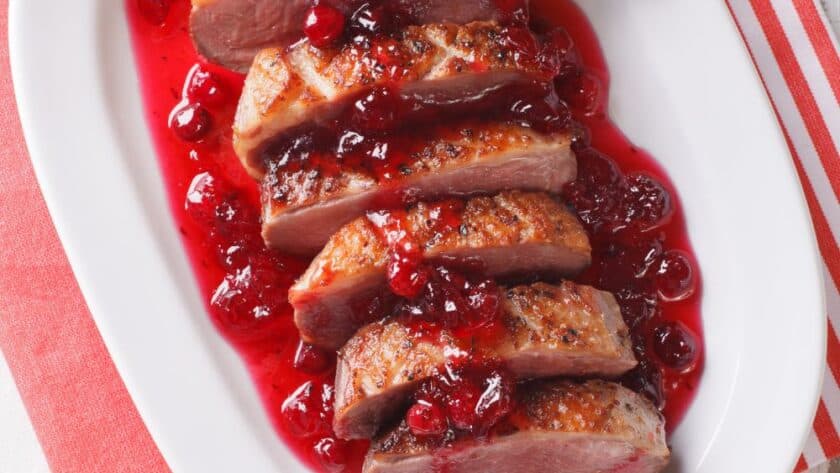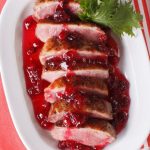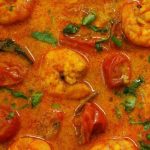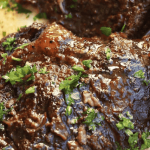The Mary Berry Duck Breast recipe is a simple yet elegant dish that highlights the rich, tender flavor of duck paired with a deliciously glossy sauce. Crispy on the outside and succulent on the inside, it’s perfect for dinner parties, special occasions, or a cozy weekend meal. Mary Berry’s approach ensures a perfectly cooked duck breast—pan-seared to crisp the skin and then gently roasted to keep the meat juicy. It’s a classic British favorite that feels luxurious yet approachable for home cooks.
What Is Mary Berry Duck Breast?
Mary Berry’s duck breast recipe features pan-seared duck breasts cooked until golden and crisp, then finished in the oven to ensure the perfect medium-rare texture. The dish often includes a light, fruity sauce—such as orange or red wine reduction—to complement the richness of the duck. It’s served alongside vegetables, mashed potatoes, or roasted parsnips for a beautifully balanced meal that’s both hearty and refined.

Other Mary Berry Recipes
- Mary Berry Vegetarian Lasagne
- Mary Berry Vegetarian Cottage Pie
- Mary Berry Game Casserole
- Mary Berry Honey Roasted Carrots and Parsnips
- Mary Berry Orange Sauce for Duck
Why This Recipe Is Worth Trying
- Restaurant-quality results – Achieve perfectly crispy skin and tender meat at home.
- Simple yet sophisticated – Ideal for both everyday dining and entertaining.
- Rich in flavor – Duck offers a deeper taste than chicken, enhanced by a fruity sauce.
- Quick to prepare – Ready in under 30 minutes with minimal effort.
- Pairs beautifully with seasonal sides – Perfect for a complete dinner spread.
Essential Ingredients to Make Mary Berry Duck Breast
- 2 duck breasts, skin on
- Salt and freshly ground black pepper, to taste
- 1 tbsp olive oil
For the Sauce (optional but recommended):
- 100ml chicken stock
- 100ml orange juice or red wine
- 1 tbsp honey or balsamic vinegar
- 1 tsp cornflour (optional, for thickening)
- Fresh thyme or rosemary sprigs (for aroma)
Handy Kitchen Tools for Best Results
- Sharp knife
- Non-stick or heavy-based frying pan
- Ovenproof dish or tray
- Small saucepan (for sauce)
- Tongs
- Foil (for resting the duck)
Step-by-Step Guide to Making Mary Berry Duck Breast
Step 1: Preheat the Oven
Set your oven to 200°C (400°F). Place a rack in the center so it’s ready when you finish searing the duck.
Step 2: Prepare the Duck Breasts
Using a sharp knife, score the skin in a crisscross pattern—be careful not to cut into the meat. This helps render the fat and creates a crisp texture. Season both sides generously with salt and pepper.
Step 3: Sear the Duck
Place the duck breasts skin-side down in a cold, dry frying pan (no oil needed). Turn the heat to medium and allow the fat to render slowly for about 6–8 minutes until the skin is golden and crisp. Flip the breasts and cook for another 1–2 minutes on the other side.
Step 4: Finish in the Oven
Transfer the seared duck breasts to an ovenproof dish and roast for 8–10 minutes for medium doneness. Adjust the time slightly depending on thickness and your preferred level of doneness.
Step 5: Rest the Duck
Remove from the oven, cover loosely with foil, and let rest for 5 minutes. This allows the juices to redistribute, keeping the meat tender.
Step 6: Prepare the Sauce (Optional)
In a small saucepan, combine stock, orange juice (or wine), and honey. Simmer until slightly reduced. If you prefer a thicker consistency, mix 1 tsp cornflour with water and stir it in. Add herbs and adjust seasoning before serving.
Step 7: Slice and Serve
Slice the duck breast diagonally, serve on warm plates, and drizzle with the prepared sauce. Pair with roasted vegetables, mashed potatoes, or green beans for a complete meal.

What I Got Wrong (And How I Fixed It)
- Overcooked the duck: Cooked too long in the oven—reduced time to 8 minutes for perfect pinkness.
- Skin wasn’t crispy: Started with a hot pan—next time started cold and let the fat render slowly.
- Didn’t rest the meat: The juices ran out—resting made the duck juicier.
- Sauce too thin: Added a little cornflour slurry to thicken without altering flavor.
Healthier Version of Mary Berry Duck Breast
For a lighter version, skip the sauce or use freshly squeezed orange juice and a drizzle of honey instead of butter or sugar. Trim excess fat from the duck and pair with steamed vegetables or a fresh salad to balance the richness.
Ingredient Substitutions for Mary Berry Duck Breast
- Duck breasts: Substitute with boneless chicken thighs or skin-on chicken breasts for a leaner option.
- Orange juice: Use red wine or pomegranate juice for a deeper, tangier flavor.
- Honey: Replace with maple syrup or balsamic glaze.
- Herbs: Swap thyme for rosemary or sage.
- Stock: Vegetable stock works well for a lighter sauce.
Pairing Ideas: What to Serve With Mary Berry Duck Breast
- Creamy mashed potatoes – Balances the rich duck flavor.
- Roasted vegetables – Adds texture and color.
- Steamed green beans or asparagus – Lightens the plate beautifully.
- Red cabbage or apple compote – Sweet and tangy contrast to the savory duck.
- Rice pilaf or wild rice – A wholesome, nutty side option.
Expert Tips for Perfect Mary Berry Duck Breast
- Start in a cold pan: Allows the fat to render gradually for crispy skin.
- Don’t rush searing: The golden crust builds flavor and locks in juices.
- Use a meat thermometer: Aim for 57°C (135°F) for medium doneness.
- Let it rest: Prevents dryness and ensures tenderness.
- Don’t cover while searing: Keeps the skin crisp.
- Save the duck fat: Use it later for roasting potatoes or vegetables.
Creative Ways to Customize Mary Berry Duck Breast
- Add a fruit glaze: Try cranberry, cherry, or plum for a festive touch.
- Incorporate spice: Add a pinch of Chinese five-spice for an aromatic twist.
- Make it sweet and tangy: Combine orange marmalade and Dijon mustard for the sauce.
- Add crunch: Top with toasted nuts like pecans or walnuts.
- Create a wine reduction: Use red wine, butter, and shallots for a restaurant-style sauce.
Storing Mary Berry Duck Breast the Right Way
- Cool completely before storing.
- Refrigerate for up to 3 days in airtight containers.
- Freeze for up to 2 months (slice first for easier reheating).
- Reheat gently to preserve moisture.
- Avoid microwaving too long as it can toughen the meat.
How to Reheat Duck Breast (If Needed)
- Oven method: Reheat at 180°C (350°F) for 8–10 minutes until warm.
- Stovetop method: Place slices skin-side down in a warm pan for 2–3 minutes.
- Microwave method: Use short 30-second intervals to avoid overcooking.
Nutritional Breakdown (per serving)
- Calories: 420
- Protein: 40g
- Fat: 25g
- Carbohydrates: 6g
- Fiber: 0g
- Sodium: 310mg
Mary Berry Duck Breast Recipe
Mary Berry’s duck breast recipe features pan-seared duck breasts cooked until golden and crisp, then finished in the oven to ensure the perfect medium-rare texture. The dish often includes a light, fruity sauce—such as orange or red wine reduction—to complement the richness of the duck. It’s served alongside vegetables, mashed potatoes, or roasted parsnips for a beautifully balanced meal that’s both hearty and refined.
- Prep Time: 10
- Cook Time: 20
- Total Time: 30 minutes
- Yield: 4 1x
- Category: Main Course
- Method: Pan-seared and oven-finished
- Cuisine: British
Ingredients
-
2 duck breasts, skin on
-
Salt and freshly ground black pepper, to taste
-
1 tbsp olive oil
For the Sauce (optional but recommended):
-
100ml chicken stock
-
100ml orange juice or red wine
-
1 tbsp honey or balsamic vinegar
-
1 tsp cornflour (optional, for thickening)
-
Fresh thyme or rosemary sprigs (for aroma)
Instructions
Set your oven to 200°C (400°F). Place a rack in the center so it’s ready when you finish searing the duck.
Using a sharp knife, score the skin in a crisscross pattern—be careful not to cut into the meat. This helps render the fat and creates a crisp texture. Season both sides generously with salt and pepper.
Place the duck breasts skin-side down in a cold, dry frying pan (no oil needed). Turn the heat to medium and allow the fat to render slowly for about 6–8 minutes until the skin is golden and crisp. Flip the breasts and cook for another 1–2 minutes on the other side.
Transfer the seared duck breasts to an ovenproof dish and roast for 8–10 minutes for medium doneness. Adjust the time slightly depending on thickness and your preferred level of doneness.
Remove from the oven, cover loosely with foil, and let rest for 5 minutes. This allows the juices to redistribute, keeping the meat tender.
In a small saucepan, combine stock, orange juice (or wine), and honey. Simmer until slightly reduced. If you prefer a thicker consistency, mix 1 tsp cornflour with water and stir it in. Add herbs and adjust seasoning before serving.
Slice the duck breast diagonally, serve on warm plates, and drizzle with the prepared sauce. Pair with roasted vegetables, mashed potatoes, or green beans for a complete meal.
FAQs
How do I cook duck breast so the skin is crispy?
Start with a cold pan and place the duck breasts skin-side down. Let the fat render slowly over medium heat for 6–8 minutes until golden and crisp. Avoid adding oil—duck fat will naturally render and crisp the skin beautifully.
Should duck breast be cooked pink in the middle?
Yes, duck breast is best served medium or medium-rare for tenderness and flavor. The internal temperature should reach about 57°C (135°F). Overcooking can make the meat tough and dry.
How do I prevent duck breast from becoming chewy?
To keep duck breast tender, avoid overcooking and allow it to rest for 5 minutes after roasting. Resting lets the juices redistribute, keeping the meat moist and flavorful.
Do I need to score the duck skin before cooking?
Yes, scoring the skin helps the fat render evenly and allows the heat to crisp it properly. Use a sharp knife to lightly cut a crisscross pattern, being careful not to slice into the meat.
Wrapping It Up
The Mary Berry Duck Breast recipe is a perfect balance of sophistication and simplicity. With its crisp golden skin, tender meat, and optional fruity glaze, it’s a versatile dish that elevates any occasion.




